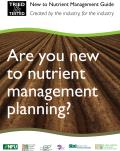The final 2017-2020 Nitrate Vulnerable Zone (NVZ) designations have been published today. (2 August 2018)
Nitrate is a vital soil nutrient for plants to grow. But excess nitrate can wash off or leach from agricultural land and pollute waterways and ground waters.
Nitrate levels are regulated and managed by various methods. From regulation with the designation of Nitrate Vulnerable Zones and the advice led approach of Farming Rules for Water which is applicable to all farmers and landowners. Compliance with NVZ rules are required for Basic Payment Scheme claimants. Voluntary approaches as well as assurance schemes also encourage farmers to adopt good practices.
Whether in or out of an NVZ all farmers and land managers need to follow the Farming Rules for Water, brought in on April 2 2018. Farmers across England need to manage manure, fertiliser and soil to prevent runoff, erosion and leaching.
"Tried and Tested resources, such as the Nutrient Management Plan help make planning and record keeping simple and practical for your farming business whilst helping demonstrate compliance if you are farming in an Nitrate Vulnerable Zone."
Find out more about our tools and resources here.
Nitrate Vulnerable Zones (NVZs)
- NVZs are areas of land draining to waters that are polluted by nitrate from an agricultural source, or which could be polluted if action is not taken. Those within an NVZ must comply with ‘Action Programme Measures’ (or NVZ rules) to reduce the risk of pollution/agricultural nitrate losses.
- The review the boundaries of the English zones every four years. The designation for 2017-2020 was made on 1 January 2017.
- Farmers whose land fell within an NVZ allowed 28 days from designation to appeal the decision.
- The verdicts from these appeals have been delivered and revised maps will be published on Thursday 2 August 2018.
- The result of the appeals reduces the pre-appeals NVZ coverage of England from 58% to 55%.
- The coverage during the 2013-17 designation was 57%.


